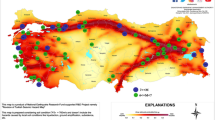Abstract
The extensive damage to buildings caused by the Nepal M s 8.1 earthquake has attracted much attention by the international community. After the preliminary scientific investigations on the different affected areas in Nepal, the construction and damage characteristics of five different types of buildings commonly existing in Nepal were discussed and the reasons of their disaster performance were analyzed. Types of buildings investigated include reinforced concrete (RC) frame structures, rubble structures, brick-wood structures, raw soil structures, and brick-wood structures of historic buildings. In addition, the weak links of the seismic design were pointed out, which was very important for the post-earthquake reconstruction and recovery, and gave a preliminary explanations for the damage experienced.
Similar content being viewed by others
References
Chang SY, Chen TW, Tran NC and Liao WI (2014), “Seismic Retroftting of RC Columns with RC Jackets and Wing Walls with Different Structural Details,” Earthquake Engineering and Engineering Vibration, 13(2): 279–292.
Chaulagain H, Rodrigues H, Spacone E, Guragain R, Mallik R and Varum H (2014), “Response Reduction Factor of Irregular RC Buildings in Kathmandu Valley,” Earthquake Engineering and Engineering Vibration, 13(3): 455–470.
Deng KL, Pan P, Alexandre L, Pan ZH and Ye LP (2013), “Test and Simulation of Full-scale Self-centering Beamto- column Connection,” Earthquake Engineering and Engineering Vibration, 12(4): 599–607.
Elkady A and Lignos DG (2014), “Modeling of the Composite Action in Fully Restrained Beam-to-column Connections: Implications in the Seismic Design and Collapse Capacity of Steel Special Moment frames,” Earthquake Engineering and Structural Dynamics, 43(13): 1935–1954.
Fakharifar M, Sharbatdar MK, Lin Z, Dalvand A, Sivandi-Pour A and Chen G (2014), “Seismic Performance and Global Ductility of RC Frames Rehabilitated with Retrofitted Joints by CFRP Laminates,” Earthquake Engineering and Engineering Vibration, 13(1): 59–73.
GB50010-2010 (2010), Code for Design of Concrete Structures, Beijing: China Architecture and Building Press.
GB50011-2010 (2010), Code for Seismic Design of Building, Beijing: China Architecture and Building Press.
GB/T17742-2008 (2008), The Chinese Seismic Intensity Scale, Beijing: China Architecture and Building Press.
Lee HS (1996), “Revised Rule for Concept of Strongcolumn Weak-girder Design,” Journal of Structural Engineering, 122(4): 359–364.
Liao WC and Goel SC (2014), “Performance-based Seismic Design of RC SMF Using Target Drift and Yield Mechanism as Performance Criteria,” Advances in Structural Engineering, 17(4): 529–542.
Lignos DG, ASCE AM, Hikino T, Matsuoka Y, Nakashima M and ASCE M (2013), “Collapse Assessment of Steel Moment Frames Based on E-defense Full-scale Shake Table Collapse Tests,” Journal of Structural Engineering, 139(1): 120–132.
NBC105 (1995), Nepal National Building Code,Seismic Design of buildings in Nepal, Nepal Ministry of Housing and Physical Planning.
Sun BT, Yan PL and Chen XZ (2014), “New Characteristics of Intensity Assessment of Sichuan Lushan “4.20” Ms7.0 Earthquake,” Earthquake Engineering and Engineering Vibration, 13(S1): 123–139.
Sung YC, Lin TK, Hsiao CC and Lai MC (2013), “Pushover Analysis of Reinforced Concrete Frames Considering Shear Failure at Beam-column Joints,” Earthquake Engineering and Engineering Vibration, 12(3): 373–383.
Wang YY (2008), “Lessons Learned from the “5.12” Wenchuan Earthquake: Evaluation of Earthquake Performance Objectives and the Importance of Seismic Conceptual Design Principles,” Earthquake Engineering and Engineering Vibration, 7(3): 255–262.
Zhang MZ and Jin YJ (2008), “Building Damage in Dujiangyan during Wenchuan Earthquake,” Earthquake Engineering and Engineering Vibration, 7(3): 263–269.
Author information
Authors and Affiliations
Corresponding author
Additional information
Supported by: National Science & Technology Pillar Program No. 2015BAK17B00 and Seismic Industry Research Special Fund under Grant No. 201508026
Rights and permissions
About this article
Cite this article
Sun, B., Yan, P. Damage characteristics and seismic capacity of buildings during Nepal M s 8.1 earthquake. Earthq. Eng. Eng. Vib. 14, 571–578 (2015). https://doi.org/10.1007/s11803-015-0046-x
Received:
Accepted:
Published:
Issue Date:
DOI: https://doi.org/10.1007/s11803-015-0046-x




